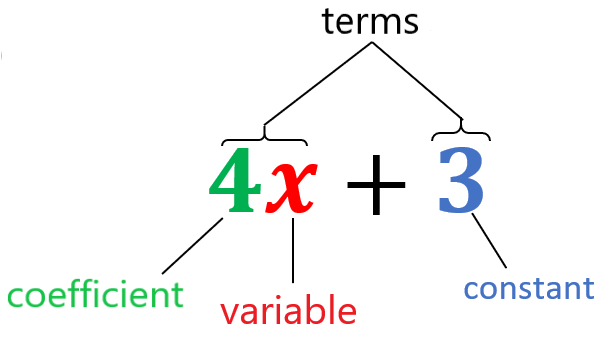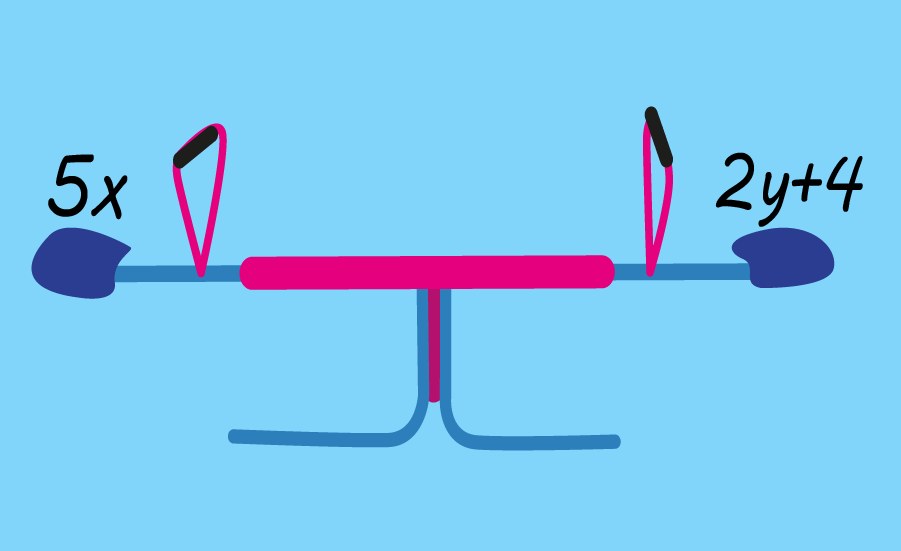Algebra is a branch of mathematics where numbers and letters are used to represent problems. Almost all mathematical problems are represented in words, so it is necessary to translate these problems into algebraic expressions in order to facilitate their resolution.
In this article, we will look at the definition of algebraic expressions. Then, we will analyze some examples and learn how to write and solve algebraic expressions.
Definition of algebraic expressions
An algebraic expression is a mathematical phrase that is composed of variables and constants along with mathematical operations (addition, subtraction, multiplication, division). Algebraic expressions are made up of terms.
These expressions are represented with the help of unknown variables, constants, and coefficients.
Note that algebraic expressions are different from algebraic equations. Unlike algebraic equations, algebraic expressions do not have sides and do not use the equal sign.
EXAMPLES
- $latex 4x+1$
- $latex 2x+3y-4$
- $latex 3x+2$
- $latex 2{{x}^{2}}+5x-1$
- $latex 10x$
Algebraic expressions – Terminology
The following diagram is an example of an algebraic expression:

In the expression $latex 4x + 3$,
- x is the variable. A variable is a letter that represents an unknown value. Other examples of variables are a, b, y, t.
- 4 is the coefficient of x. The coefficient is a numerical value used in conjunction with a variable.
- 3 is the constant. A constant is a term that has a definite value.
- 4x and 3 are the terms. A term can be a number, a variable, or the combination of numbers and variables.
Types of algebraic expressions
There are three main types of algebraic expressions, which include:
- Monomial expression
- Binomial expression
- Polynomial expression
Monomial expression
An algebraic expression that has only one term is known as a monomial. Examples of monomials include $latex 2x, 3xy, 2{{x}^{2}}$, etc.
Binomial expression
A binomial is an algebraic expression that has two terms that are not “like terms”. Examples of binomials include $latex 4x+2, 5xy+1, {{x}^{3}+2}$, etc.
Polynomial expression
In general, an expression with more than one term with non-negative integer exponents of variables is known as a polynomial. Examples of polynomials include $latex ax+cy+b, {{x}^{3}+5x+1}$, etc.
Simplify algebraic expressions
Most of the time, we try to convert expressions into their simplest form so that they are not complex or confusing. One way to simplify expressions is to combine like terms. Like terms contain the same variable or variables with the same exponent.
EXAMPLES
- Simplify $latex 5x+1+3x+6$
Answer: $latex 8x+7$
- Simplify $latex 3{{x}^{2}}+4x+5{{x}^{2}}+2x$
Answer: $latex 8{{x}^{2}}+6x$
- Find the simplest form of $latex 2{{x}^{3}y}+3+3{{x}^{3}y}+5$
Answer: $latex 5{{x}^{3}y}+8$
- Simplify $latex 4{{x}^{2}y}+3x+5{{x}^{2}y}+4x$
Answer: $latex 5{{x}^{2}y}+7x$
Try solving the following practice problems
Examples of solving algebraic expressions
The purpose of solving an algebraic expression in an equation is to find the value of the unknown variable. When we connect two expressions using the equal sign, we form an equation and therefore it becomes easier to solve for the unknown terms.
To solve an equation, place the variables on one side and the constants on the other side of the equation. Variables can be solved by applying arithmetic operations such as addition, subtraction, multiplication, division, etc.
EXAMPLES
- Find the value of $latex x$ in the equation $latex 4x+2=14$
Solution: Given the equation $latex 4x+2=14$, we separate the variables and the constants:
$latex 4x=14-2$
Now, we substract the constants:
$latex 4x=12$
We divide both sides by the coefficient of the variable:
$latex x=12/4=3$
Therefore, the value of $latex x$ is 3.
- Find the value of $latex y$ in the equation $latex 5y+4=24$
Solution: Given the equation $latex 5y+4=24$, we separate the variables and the constants:
$latex 5y=24-4$
Now, we substract the constants:
$latex 5y=20$
We divide both sides by the coefficient of the variable:
$latex y=20/5=4$
Therefore, the value of $latex y$ is 4.
- Find the value of $latex t$ in the equation $latex 6t+5=3t+11$
Solution: Given the equation $latex 6t+5=3t+11$, we separate the variables and the constants:
$latex 6t-3t=11-5$
Now, we subtract the constants and the variables:
$latex 3t=6$
We divide both sides by the coefficient of the variable:
$latex t=6/3=2$
Therefore, the value of $latex t$ is 2.
Try solving the following practice problems


Algebraic expressions – Frequent questions
How to derive algebraic expressions?
An algebraic expression is a combination of variables, constants, and operations (addition, subtraction, multiplication, division). We can derive the algebraic expression for a certain situation by using these combinations.
For example, Carlos has 5 more apples than twice as many as Fernanda has, and she has 20 apples. Expressing in algebraic form, we have:
$latex 2x+5=20$
$latex 2x=15$
Is 5 an algebraic expression?
No, 5 is not an algebraic expression since an expression must have at least one variable and one operation to be algebraic.
What is a variable in an algebraic expression?
A variable is an unknown value that can be found by evaluating a given algebraic equation.
Are all algebraic expressions polynomials?
No, not all algebraic expressions are polynomials. But all polynomials are algebraic expressions. The difference is that polynomials only include variables with mathematical operations (addition, subtraction, multiplication, division), but algebraic expressions also include irrational numbers in powers.
See also
Interested in learning more about algebraic expressions? Take a look at these pages:




